In the first of a series of special updates, TrekCore talks to Robert Meyer Burnett, one-half of the talented duo responsible for the creation of the new bonus features on Star Trek: The Next Generation‘s remastered Blu-Ray releases. Normally to be found beavering away in his edit bay, Rob generously took several hours out of his busy schedule to talk to me about all things Star Trek, answering questions about his work and dropping several juicy hints about the exciting things he and Roger Lay Jr. have planned for future Star Trek Blu-Ray releases.
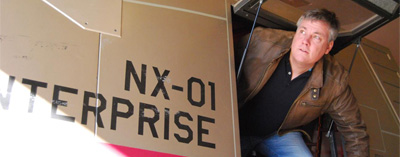
Robert Meyer Burnett: Who Interviews the Interviewer? Part 1
Interviewed by Adam Walker for TrekCore.com
![]()
TrekCore: Rob it’s great to talk to you again, thanks for taking the time out to talk to TrekCore. A lot of fans obviously know you for your work producing and editing the new bonus features on the Star Trek: The Next Generation Blu-Rays. It’s probably the area of the industry you’re most focused on at the moment, but you’ve also worked on other Star Trek bonus features in the past including Star Trek V: The Final Frontier for Paramount Pictures. Tell us a little bit about that, how did you find working on one of the original Star Trek movies?
Robert Meyer Burnett: Well, to be quite honest, I fucked up my job on [the DVD release of] Star Trek V. Badly. (Laughs)
When I was hired, I was also working on Lord of the Rings, and I was back and forth from New Zealand. I was there a long period of time and I was not working within the timeframe Paramount wanted, and unfortunately, I wasn’t able to devote all of my efforts the way that I wanted to – but, on Star Trek V, I was able to do what I think was the definitive interview ever done with William Shatner. That’s on the disc; I just wish they used a lot more of it. I also recorded the audio commentary for Star Trek V, and ran in to difficulty with that audio commentary because there’s a lot of missing material – I sort of went head-to-head with [Paramount’s legal division] because at the time, on the commentary, Shatner made mention of the fact that his idea for Sybok – his conception of Spock’s half-brother – was that Sybok was [psychologist and writer] Timothy Leary.
Timothy Leary was a great counter-culture figure in the 1960’s who advocated drug use and expanding your mind via LSD. I would get legal notes back from Paramount legal saying “You cannot equate ‘Star Trek’ and drug use! We just don’t do that.” I, of course, was totally annoyed by that, because that is bullshit. That was studio legal bullshit that had no bearing on any reality.Star Trek dealt with drugs all the way back to the first season of The Original Series, and “Mudd’s Women” with the Venus drug. The first season of The Next Generation has a great –
TrekCore: Yes, “Symbiosis”!
Robert Meyer Burnett: Yeah – and by the way, “Symbiosis” plays better now than it played back then. The drug allegory, and the fact that pharmaceutical companies today would rather have you hooked on Zoloft or Percocet… you watch that now and it’s like, wow! “Symbiosis”, which at the time – a lot of people don’t consider that maybe a great episode – to me, just watching the remastered version, not only is it a Star Trek II reunion with Merritt Butrick and Judson Scott, but it really works well as a drug allegory, even now – more so now than ever.
I’d always wanted to do a Director’s Cut of Star Trek V just as Paramount had done earlier with Star Trek: The Motion Picture, and I really wanted to go in and rebuild – or at least have CGI versions of – the rock men, and really redo the ending of Star Trek V and fix things. There’s a lot of really sloppy, bad work. The famous ‘rocket boots up the corridors of the Enterprise’ that are backwards, and there are way too many decks on the Enterprise; you’re at like Deck 75, then you’re at Deck 50, then you’re back up to Deck 75 again, or whatever the numbers are… it’s like, come on, man! We all know that Deck 1 is the bridge, and it goes down from there!
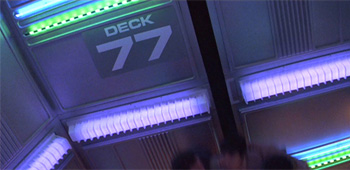
Star Trek V: The Final Frontier contained a lot of “sloppy, bad work” which Robert Meyer Burnett had always hoped to rectify in a more polished Director’s Cut on DVD.
I wanted to fix all that, because I think the great problem with Star Trek V is the tone. I think there’s a much better – you could go in there and recut and restructure that movie and get rid of all the really dumb humor. Once those really horrible tonal inconsistencies were fixed, there’s a really emotional, really touching movie in there. But what it needed… now that we’ve got time, and in hindsight you can look at that and say look, the studio – because Star Trek IV was the biggest-grossing Trek film at that time – the studio said “Okay, you have this very serious, thoughtful movie, but you have to inject humor into it.”
William Shatner, as far as humor is concerned, he tends to go very broad. He likes broad humor. One of the things I said to him when we were making Free Enterprise, knowing that, was “You know, Bill, this film would not work with a lot of broad humor. The only way ‘Free Enterprise’ is going to work is if the audience at any one time has to wonder – is your character serious, or are you insane?” Shatner was like “Oh, I totally get that. I get that. You’re exactly right.”
He played it that way, and I think that if Star Trek V… if they made the ‘Row, Row, Row Your Boat’ humor – if they played it the same way, but not as broadly – it would have been even funnier! “I don’t think you know the gravity of the situation!” and Spock, you know, swoops down like Superman and saves Kirk… come on, dude. That’s just really goofy. The fan dance, Scotty hitting his head on the bulkhead, “Don’t you know a jailbreak when you see one!”… it’s like, could we tone this stupid humor down?
I think Star Trek V has great moments in it, and I think that if you had somebody come in… also, the problem is – from an economic standpoint – of all the original films, it’s the least-selling. It has the least amount of box office [revenues], so you’re not going to get the people to invest any money into it because the sales figures don’t bear that out.
TrekCore: So fast-forwarding a few years, tell us a little bit about how CBS brought you and Roger Lay together to work on the bonus features for the Blu-Rays for Star Trek: The Next Generation.
Robert Meyer Burnett: Well, it’s really interesting. There’s an executive at CBS named Ana Barretto – Ana is a filmmaker in her own right – she was working on a documentary called The Table, about Marc Scott Zicree and his merry band of ne’er-do-wells, how he has this weekly meeting for people that live in Hollywood as a support system. It’s almost like Alcoholics Anonymous, but for people that want to get involved with the movie business; it’s sort of a way to network and help people out. Ana was in our office – I was editing a feature film called My Eleventh, the first feature from Gary and Edmund Entin, who were actors, I had known them for years and had worked with them on other DVDs – we were both in the offices of Gary Goddard, who created the [Las Vegas-based] Star Trek Experience.
So I was cutting this feature film, and Roger was working on this documentary – and unbeknownst to me, Ana was an executive at CBS Home Entertainment and she was talking to Roger about the fact that they were going to start this Blu-ray project. They were actually going to pull the trigger on the Star Trek restoration, they decided to –
TrekCore: Ah! So was that the first time you heard about TNG being remastered?
Robert Meyer Burnett: That was the first time ever. I remember having a conversation with them… I would walk by Roger’s cubicle every day and say hello, but I didn’t really know him – we’d see each other working, because I was always ensconced in my edit bay, cutting – one day we stopped and I realized that Roger’s a huge Star Trek fan, like he knows his shit! Then I started talking to Ana about what would go on – like, wouldn’t it be great if we could work on the special features?
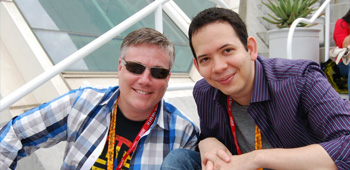
Robert Meyer Burnett and his Trek VAM partner Roger Lay Jr.
So, Roger started consulting for CBS with Ana. He’d go in and talk to them – at first, they weren’t going to do any new VAM [Value Added Material, aka Special Features] at all. I think it was Roger’s persistence, and really getting in the trenches and saying “No, you can’t do a ‘Star Trek’ restoration and not do new VAM. You can’t do that.” So he’d been working… he’d actually been shooting footage – he wasn’t even hired – but the stuff that’s in the ENERGIZED! documentary, when he interviewed Dave [Grant] and Ryan [Adams] in the vault where they were keeping all the negatives… Roger, just hoping they’d pull the trigger, spent almost six months just shooting footage. Whenever he could, he would go to the turnover sessions when the Okudas started looking at the new visual effects at CBS Digital. He was there with his camera, shooting things in the hope that they would pull the trigger and want to make new VAM.
It’s kind of like what I did with Superman Returns. I was shooting material on Superman Returns six months before I was even hired, which is why I was there the day Brandon Routh had his screen test for the studio. I had that priceless footage of him getting his hair cut, and getting the glasses, and things like that – you know, it was only because of Roger’s love of Star Trek that he was doing it for free, because he had better things to do, but that’s the way we roll here! (Laughs)
So then they finally pulled the trigger, and CBS Home Entertainment with Ken Ross and Phil Bishop and Angelo Dante and Ana Barretto, they basically said “Go ahead!” and the first thing Roger did was hire me. It was decided… Roger has been very gracious. We both produced – he said to me, “Your track record as a DVD producer is exemplary, so you’ll produce it with me.”Roger takes the directing credit, which is fine, it’s his gig; I edit; we both produce. I’ve never had a more fruitful or satisfying working relationship with any colleague in the entertainment business – ever – than I’ve had with Roger. We both don’t have any ego between us. We have an ego when it comes to the fact that we want to be good, but he and I are both on the same page in terms of what we want.
We’re relentless in our pursuit of getting as many people as we can – like, we were not going to stop with not getting Diana Muldaur. I mean, Roger was on the phone with Diana, sending her e-mails… we were basically saying, “We can’t not have you.” She wasn’t in the best of health, and she’d been in the hospital… right after she came out of the hospital she agreed to do the interview for us, and she was just the sweetest, most delightful woman. The fact that we were so persistent – that Roger was so persistent – was totally endearing to her, and she had so much fun and was so sweet. We were really lucky.
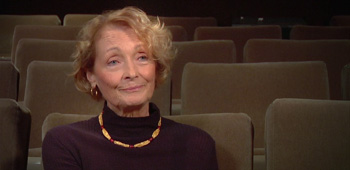
The new interview with Diana Muldaur almost didn’t happen, but it’s a testament to the dogged determination of all involved that we’re able to hear Diana’s views.
CBS Home Entertainment has been, I think, astonished by what we’ve accomplished. To their credit, once we started doing this, Ken Ross was like – if we had a problem securing the cast – Ken was like, “I’m going to do whatever it takes.” Ken Ross has really shepherded this project and made sure… I mean, I’ve never had an executive EVER show as much interest or as much care, and give us as much support as Ken Ross has. Ken will call us in the edit bay on a weekend – he’ll know that we’re going to be here – it’ll be two o’clock in the morning and he’ll be like, “Guys! How’s it going? What’re you doing? You got anything new to show me? What’s going on?”
He really has been amazing. He watches all of our cuts – and I have to tell you, at first I thought “Oh god, we’re going to have a network executive riding roughshod over us…” – but not being a total Next Generation fan, every time we get notes from him… I’m not just blowing smoke up his ass, he has questions about the stories that we’re telling. He asks us logic questions – because we already know so much that we sometimes forget that we have to make sure our documentaries are clear for the layman that’s coming at these things for the first time. There’s been no better gauge of that then Ken Ross. Every time he’s ever given us notes, I can say he’s only ever made our pieces better and more concise, which has been great. Just the fact that he gets excited about what we’re doing is really, really nice.
Also, the support we get from Phil and Angelo and Ana… I wrote Angelo a letter yesterday. I mean, Angelo is always relentlessly finding things. He might not know what they are, but he’ll call up and he’ll say, “Roger, Rob, I found this box full of tapes – I don’t know what it is!” He’ll get it for us – no one has looked in this box for twenty-five years – and we’ll find like three-quarter-inch tapes of Nagilum tests, you know, that are on the Season Two documentary. It’s like “Where do these come from?!” No one has ever seen them before, but because we have the support it’s been great to find things.
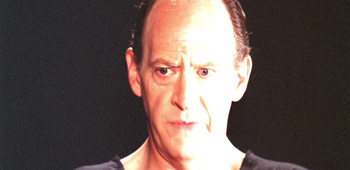
The early test footage of Nagilum, played by actor Earl Boen, was included on the TNG Season 2 Blu-Rays. Robert Meyer Burnett describes how he was shocked and excited to see the footage for the first time.
I’ll tell you one of the things we’ve found that is pretty exciting – we haven’t used it yet – when The Next Generation was first talked about, they had to figure out how they were going to do the visual effects. There was talk at the time – this was just a couple of years after The Last Starfighter, when they did all those space visual effects – that there was talk about going all-CG. In 1987.
Various effects houses did a sort of bake-off, where they were given some footage from Star Trek III to do transporters and phaser fire… then they were asked to do CG models of the Enterprise. So we have these tests that these various effects companies did of visual effects – what the visual effects would have looked like had they been all CG. Ultimately, they were a little, uh, crude – to say the least – so they opted not to go that route, and they opted to go with models and motion control, THANK GOD, but we have this footage, and we’re going to use it on one of the subsequent releases. We don’t know when, because it’s not season-specific, but it’s crazy to have! It’s just something that was on a tape, Angelo found a box with tapes in it, we looked at the tapes, and there was this footage.
Roger and I… one of the great, fun things about this project is that we get these tapes, and we just look at each other like “Oh my god, no one’s ever looked at this stuff! Ever!” It might just be snippets, but even if we’ve got one shot of a Nagilum test… we try and use shots of everything we’ve got, but the Nagilum test, to me – having [actor] Earl Boen and all that – just being able to see, is great! Because it’s never shown up in books anywhere, and just to have it all…
In the Season Two documentary, I used every bit of footage from the Star Trek Phase II footage that existed. All of it. Everything. There is no more! (Laughs) There was some of it, in the Star Trek: The Motion Picture Director’s Cut DVD, but I used all of it that existed that I could squeeze in.
***
ROBERT MEYER BURNETT wrote and directed FREE ENTERPRISE and produced Warner Premiere and Dark Castle’s THE HILLS RUN RED.
 | Order Star Trek: The Next Generation Season 1 Blu-Ray today! |  | Order Star Trek: The Next Generation Season 2 Blu-Ray today! |
